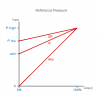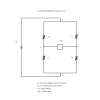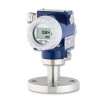EPDM is a type of rubber seal material which offers excellent resilience against solvents, antifreeze and aviation hydraulic fluids.
Measurement & Instrumentation Guides
Guidance and reference articles for sourcing, setting up and using measurement equipment.
ftH2O – Feet of Water Column at 4 deg C Pressure Unit
Foot of Water Column is an American and English low value pressure unit
g Effect
The g Effect is a change in performance of a pressure measuring device that is caused by a change in its orientation. Typically a pressure sensing device will have some form of flat diaphragm which will generate a change in output when flexed by a change in pressure. If a pressure sensing diaphragm is orientated […]
g/cm² – Grams per Square Centimetre Pressure Unit
Grams Force per Square Centimetre is a cgs system pressure unit which is now largely obsolete and officially superceded by the SI system of units.
g – Acceleration due to Gravity
Gravity (g) which is defined by an acceleration of 9.80665m/s² is the designated average accelerating force due to Earth’s gravity at sea level.
hPa – Hectopascal Pressure Unit
Hectopascal is a 100x multiple of the pascal which is the SI unit for pressure.
HART®
HART® or Highway Addressable Remote Transducer is a type of digital communications protocol for configuring and reading instrumentation via 4-20mA signal.
Hydrostatic Pressure
Hydrostatic pressure is the pressure that is generated by the weight of liquid above a measurement point, when the liquid is at rest.
Hygienic
Hygienic measurement instrumentation are designed for use by the food, drink and pharmaceutical industries, which require a high level of cleanliness in their manufacturing processes.
inH2O – Inches of Water Column at 4 deg C Pressure Unit
Inches of water gauge or column is an english and american unit for measuring liquid level. 1 inch of water column at 4 degrees celsius equals 249.089 Pa.
inHg – Inches of Mercury at 0 degrees C Pressure Unit
Inch of Mercury is a British and American unit of measure for pressure. 1 inch of mercury at 0 degrees Celsius (32 deg F) equals 3386.39 pascals. An inch of mercury at zero degrees Celsius is defined as the pressure exerted by a column of mercury with a density of 13,595.1 kg/m3 under the pull […]
kg/cm² – Kilogram per Square Centimetre Pressure Unit
Kilogram Force per Square Centimeter is a pressure unit that has been largely superseded by the SI unit system of pascal units.
kPa – Kilopascal Pressure Unit
The kilopascal is a x1000 multiple of the pascal unit which is the SI unit for pressure. 1 kilopascal equals 1,000 Pascals.
MPa – Megapascal Pressure Unit
The megapascal is a x1000000 multiple of the pascal unit which is the SI unit for pressure. 1 megapascal equals 1,000,000 pascals.
mH2O – Metres of Water Gauge at 4 deg C Pressure Unit
Meters of water gauge or column is a metric unit for measuring liquid level. 1 metre of water column at 4 degrees Celsius equals 9806.65 pascals.
µHg – Micron of Mercury at 0 deg C Pressure Unit
Micron of Mercury is a very small pressure unit derived from the pressure that is generated by a 1 micrometer (1/1000mm) column of liquid mercury.
mbar – Millibar Pressure Unit
Millibar is a metric unit of pressure mainly used in European countries and is derived directly from the bar pressure unit which equals 1,000 mbar.
mmH2O – Millimetres of Water Column at 4 deg C Pressure Unit
Millimeters of Water Column is a low range metric pressure unit derived from the hydrostatic pressure of 1mm head of water at 4 degC.
mmHg – Millimetres of Mercury at 0 deg C Pressure Unit
Millimeters of Mercury at a temperature of 0degC is a small metric pressure unit derived from the pressure generated by a 1mm tall column of mercury liquid.
mTorr – Millitorr Pressure Unit
Millitorr is a very small pressure unit used for high vacuum measurements and is a 1/1000x multiple of the torr pressure unit.
Negative Gauge Pressure
Negative Gauge Pressure is the difference in pressure between any vacuum and atmospheric pressure. The maximum possible negative gauge pressure is always limited by the current ambient atmospheric pressure, which constantly varies, but is typically around 1 bar absolute.
N/m2 – Newton per Square Metre Pressure Unit
Newtons/Square Meter is a unit that shows how the pascal unit is derived from other SI units. Pressure is defined as Force/Area and the SI unit for Force is newtons (N) and the SI unit for Area is Sq Meters (m²). 1 newton per square metre equals 1 pascal. The N/m² pressure unit is one […]
LHR – Linearity, Hysteresis and Repeatability
Linearity, Hysteresis and Repeatability (LHR) is often used to describe the room temperature precision of a pressure sensor, excluding all zero & span offsets, temperature errors and long term stability. Also see non-linearity and pressure hysteresis.
oz/in² – Ounce per Square Inch Pressure Unit
Ounce or Ounce Force per Square Inch is a low pressure unit which is part of the British and American system of units.
PPM – Parts Per Million
Parts Per Million (PPM) is a ratio used to describe the maximum measurement error or resolution of pressure measurement equipment.
Pa – Pascal Pressure Unit
Pascal is the SI unit for pressure and is derived from other SI units using the following relationship: Pa = (kg.m/s²)/m² = kg/m.s² = N/m².
Dead Weight Tester
A Dead Weight Tester is an instrument which uses metal weights and a piston/cylinder assembly to generate pressure calibration setpoints to a high accuracy.
Piezoresistive Strain Gauges
Piezoresistive strain gauges are a semiconductor material which changes in resistance when the material stretched or compressed.
psf – Pounds per Square Foot Pressure Unit
Pounds Force per Square Foot is a British (Imperial) and American pressure unit which is directly related to the psi pressure unit by a factor of 144.
psi – Pounds per Square Inch Pressure Unit
Pounds or pound force per square inch (psi, lb/in², pfsi or lbf/in²) is a widely used British and American unit of measure for pressure.
Pressure
Pressure is the amount of force applied to a unit area and is calculated by dividing the applied force by the area of the contact surface.
Pressure Transducers
A pressure transducer is a device which converts an applied pressure into a measurable electrical signal.
Primary Pressure Reference Standard
Primary pressure reference standards are used to measure and generate pressures to a high level of accuracy and repeatability for calibration purposes.
Reference Pressure
Reference Pressure is the pressure present on the reverse or negative side of a pressure sensing element.
SG – Sealed Gauge
Sealed Gauge (SG) is a type of reference pressure measured relative to a fixed pressure of approximately 1 bar absolute.
Secondary Pressure Standard
Secondary Pressure Standards are pressure calibration instruments which have to be checked by primary pressure standards on a regular basis.
Specific Gravity
Specific gravity is a comparison ratio between the density of a particular substance and the density of a reference substance.
atm – Standard Atmosphere Pressure Unit
Standard Atmosphere is mainly used as a reference value for the average atmospheric pressure at sea level.
Static Line Pressure
Static Line Pressure is the total pressure present at a particular point along a pressurised pipe.
Suction Pressure
Suction pressure is a negative difference in pressure generated between two points which draws a gas or a liquid from a higher to a lower pressure state.
at – Technical Atmosphere Pressure Unit
Technical Atmosphere is used to represent a pressure value in multiples of atmospheric pressure.
Threshold
Threshold is the amount of measurement change required before a measuring instrument reacts with a change in measurement output or produces a specified result.
tsf – Tons per Square Foot (USA, Short) Pressure Unit
Tons or Tons Force per Square Foot (USA, Short) is an American pressure unit comparable in magnitude to atmospheric pressure.
tsi – Tons per Square Inch (UK, Long) Pressure Unit
Tons or Tons Force per Square Inch (UK, Long) is a very large pressure unit used historically for measuring extremely high pressures.
tsi – Tons per Square Inch (USA, Short) Pressure Unit
Tons or Tons Force per Square Inch (USA, Short) is one of the largest pressure units and is used in the measurement of ultra high pressures. 1 ton per square inch (usa, short) equals 13,789,500 pascals. This is the American version of tons per square inch which uses the so called short ton that is […]
Torr Pressure Unit
Torr is a pressure unit which is defined as 1 standard atmosphere divided by 760 (1 atm/760 or 101325 Pa/760).
Rangeable
Rangeable describes a measurement instrument function which allows the operator to adjust the output signal scaling to a different measurement range.
Span Offset
Span Offset is the amount of deviation in output or reading from the exact value at a point within the measurement span.
Span
Span is the difference between the lowest and the actual reading or output signal of a measurement device.
Span Sensitivity
Span Sensitivity defines the output signal characteristic of a strain gauge based sensor independent of measurement range or supply voltage.
Square Root Extraction
Square Root Extraction is a mathematical process which is applied to a linear measurement scale to convert it to a non-linear square root scale.
TSS – Thermal Span or Sensitivity Shift
Thermal Span or Sensitivity Shift signifies the maximum amount of span that will change at any measurement point within the compensated temperature range.
TEB – Total Error Band
Total Error Band (TEB) is the difference between the most negative and most positive deviation from the true measurement, determined from the combination of all known errors for a sensing device, within the constraints of the measurement and operating temperature range. Typically in the case of a pressure measurement device for example, the total error […]
Transmitter
Transmitter (Tx) is a device which converts a sensor output into an analogue signal suitable for sending over long distances without significant signal loss or interference. A common type of sensor transmitter signal is a 4 to 20 milliamp current loop output.
Turndown Ratio
Turndown Ratio describes the difference between the highest and lowest possible span of measurement output which can be set for a sensing device with a rangeable output signal such as 4 to 20mA output which is HART enabled.
Vented Cable
Vented Cable has a vent tube running through the inside of the cable to provide a vent path between the electrical connections at either end.
Water Density
The density of fresh water at a temperature of approximately 4 degrees Celsius is 1000 kg/m3.
Wet/Dry
Wet/Dry describes a dp measurement device for use with a liquid on the positive pressure side and a dry/non-condensing gas on the negative pressure side.
Wet/Wet
Wet/Wet describes a differential pressure measurement device which is compatible with liquid on both the positive and negative side process connections.
Wheatstone Bridge Strain Gauge
Wheatstone bridge strain gauge circuits are used extensively inside transducer to convert a mechanical strain into an electrical output signal.
Zero Offset
Zero Offset is the amount of deviation in output or reading from the exact value at the lowest point of the measurement range.
Zero Tare
Zero Tare is the operation of removing a zero offset to help obtain the optimal measurement over the whole measurement range.
2 Wire
2 wire is used to distinguish electrical connections for measurement signals which use only two connections for carrying both the power supply and signal.
4 to 20 mA Current Loop Output Signal
4-20mA Current loop output is a type of electrical signal that is used in a series circuit to provide a robust measurement signal.
3 Wire
3 wire is used to describe a type of electrical connection for a measurement signal which has only three connections for the power supply and signal output
Wetted Parts
Wetted Parts are the measurement side components of a sensing device which are in contact with the liquid media to be measured.
UKAS Calibration Certificate
UKAS Calibration Certificate is a formal document that details the procedure and results for a calibration completed by a UKAS certified calibration laboratory.
Transducer
Transducer is a device which measures a physical quantity such as temperature or pressure and converts it into an electrical output signal.
Traceable Calibration
Traceable Calibration is carried out using equipment that is regularly calibrated by a reference source that can be traced back to a national standard.
TZS – Thermal Zero Shift
Thermal Zero Shift (TZS) is the maximum amount the output or reading at the null measurement point might deviate over the compensated temperature range
Thermal Hysteresis
Thermal Hysteresis is the measured change in output or reading at a specific measurement point taken during a sequence of increasing and decreasing temperature.
TSL – Terminal Straight Line
Terminal Straight Line (TSL) is a straight line drawn between the measurement output at zero and at full scale.
TEB – Temperature Error Band
Temperature Error Band (TEB) is the error derived from the most positive and negative deviation of all measurement points within a measurement range over the operating or compensated temperature range.
Temperature Error
Temperature Error is the deviation of a measurement reading caused by a change in media or environmental temperature.
Temperature Compensation
Temperature Compensation is a correction applied to a measurement instrument to reduce errors attributed to temperature changes in a process media which is being measured or in the surrounding environment that the instrument is being used.
SOI – Silicon on Insulator
Silicon on Insulator (SOI) is a type of material technology which can be utilised in the manufacture of pressure sensor diaphragms to allow operation at higher temperatures.
Repeatability
Repeatability is the amount of change in a measured reading at the same measurement point after a defined number of cycles over the measurement range or a set of environmental limits.
RTE – Referred Temperature Error
Referred Temperature Error is the max deviation expressed as a +/- %FS from measurements taken at a defined temperature.
Accuracy
Accuracy of a measurement instrument defines how much a measurement value may deviate from the perfect measured value.
Precision
Precision is the measure of how closely a set of readings will be to a reference line that passes through the middle of all the points.
PVC – Polyvinyl Chloride
PVC is a widely used plastic which is cheap to produce and hard enough to be used as a component parts construction material.
PUR, PU – Polyurethane
Polyurethane is a durable polymer used for coating cables, a water tight sealing compound and a potting compound to protect electronics from damage.
FFKM – Perfluoroelastomer
Perfluoroelastomer (FFKM) is a seal material type which has a much higher temperature rating than the more common FKM and can be used on temperatures up to 300°C. FFKM also has a broader chemical resistance than FKM.
Oxygen Service
Select Oxygen service measurement products to use in atmosphere which contains high levels of Oxygen or measure gas containing high concentrations of O2
NO – Normally Open
Normally Open (NO) refers to the state of an electrical switch contact which stays open until a preset threshold has been met and the switch closes, e.g. a NO pressure switch set at 10 bar will close once the pressure exceeds 10 bar.
NC – Normally Closed
Normally Closed (NC) refers to the state of an electrical switch contact which stays closed until a preset threshold has been met and the switch opens, e.g. a NC pressure switch set at 10 bar will open once the pressure exceeds 10 bar.
NL – Non-Linearity
Non-Linearity is the deviation error derived from the straightness of a set of recorded measurements when compared to a straight line, such as bsl or tsl, drawn through all the results. The maximum non-linearity error is normally expressed as a percentage of full scale.
NPL – National Physical Laboratory
National Physical Laboratory (NPL) – national measurement institute for the United Kingdom. This organisation is responsible for maintaining the primary measurement standards for the UK.
Mechanical Stop
Mechanical Stop is an internal component which protects pressure sensing components from overpressure by limiting the deflection of the diaphragm.
MTBF – Mean Time Between Failures
MTBF or mean time between failures is a theoretically calculated value which considers all the components used in the construction of a measurement device.
MSL – Mean Sea Level
MSL or Mean Sea Level is the average height of the ocean surface. Mean sea level is a significant datum reference for meteorological and altitude related pressure measurements, e.g. standard atmospheric pressure at mean sea level is 1013.25 hPa or 29.92 inHg.
Long Term Stability/Drift
Long Term Stability or Long Term Drift is the amount of change of a measured reading at exactly the same pressure and ambient conditions over a given period of time which is typically quoted as an annual figure.
LVDT – Linear Variable Differential Transformer
The Linear Variable Differential Transformer (LVDT) is a type of sensor which converts linear displacement into an variable electrical signal.
Isolation Diaphragm
An Isolation diaphragm is a thin membrane which is used to isolate the media on one side of a diaphragm from media on the other side.
IP Ratings
The IP Rating is an accepted engineering standard for defining the protection of electrical equipment from dust and moisture ingress.
Pressure Hysteresis
Pressure Hysteresis is the difference between two separate measurements taken at the same pressure but one where the pressure was increasing and the other where the pressure was decreasing. The hysteresis is caused by the natural reluctance of a pressure sensing material such as a diaphragm to return to its original position, shape or form […]
Gauge Reference Pressure
Gauge reference pressure is a pressure measured relative to atmospheric or barometric pressure. The most used pressure reference is gauge pressure which is signified by a (g) after the pressure unit (e.g. 30 psi g), and means that the pressure measured is the total pressure minus atmospheric pressure. There are two types of gauge reference […]
Flush Diaphragm
A guide to flush diaphragm pressure & level measurement instrumentation, including explanations, applications and a choice of products with flush process fittings.
FSO – Full Scale Output
Full Scale Output (FSO) can have two meanings. The first meaning is that it is the resulting output signal or displayed reading produced when the maximum measurement for a given device is applied. The second meaning applies to the difference between the minimum and maximum output value. Full Range Output (FRO) and Full Span Output […]
FS – Full Scale
Full Scale (FS) is the difference between the lowest and highest possible measurement point






















